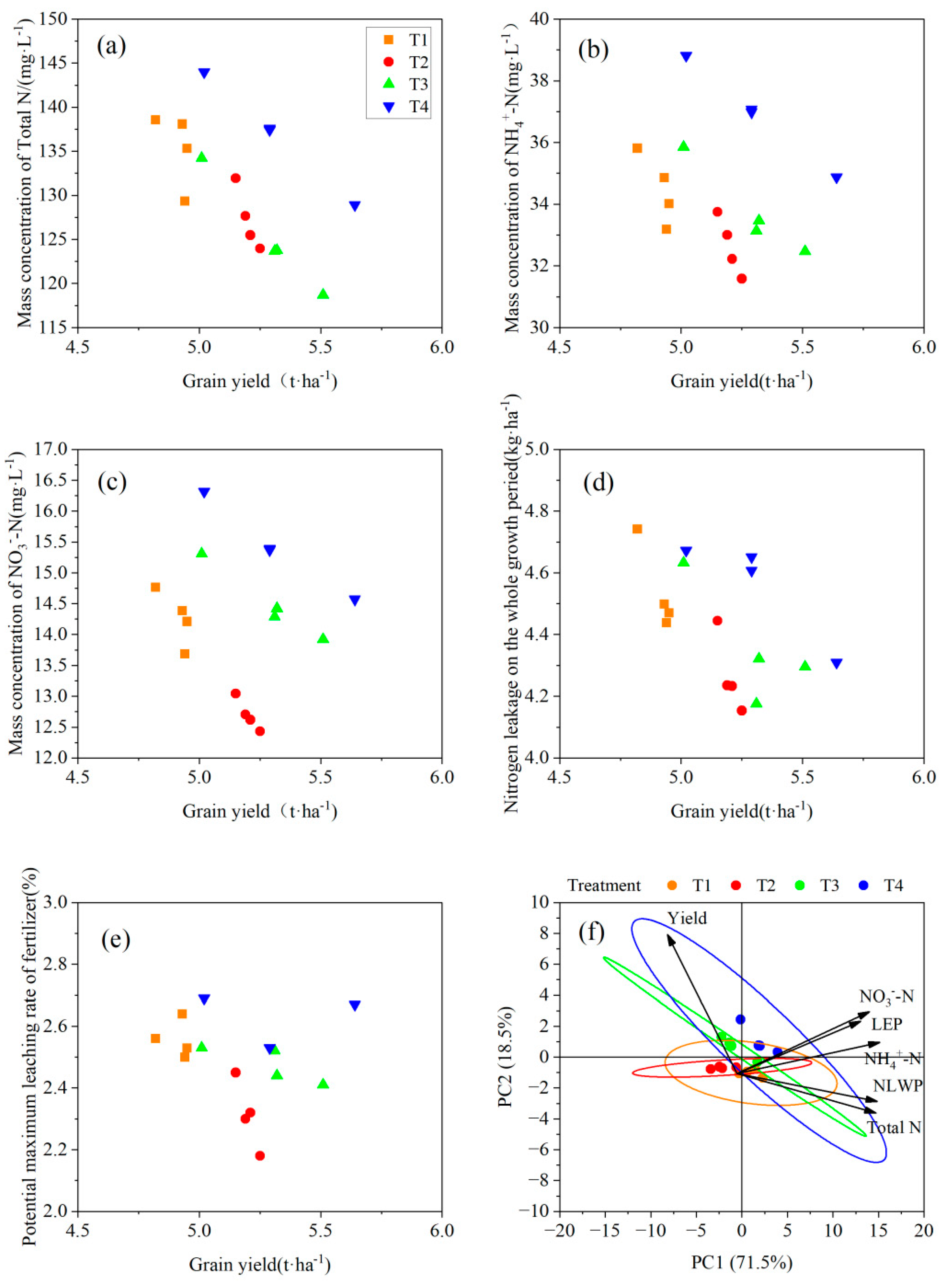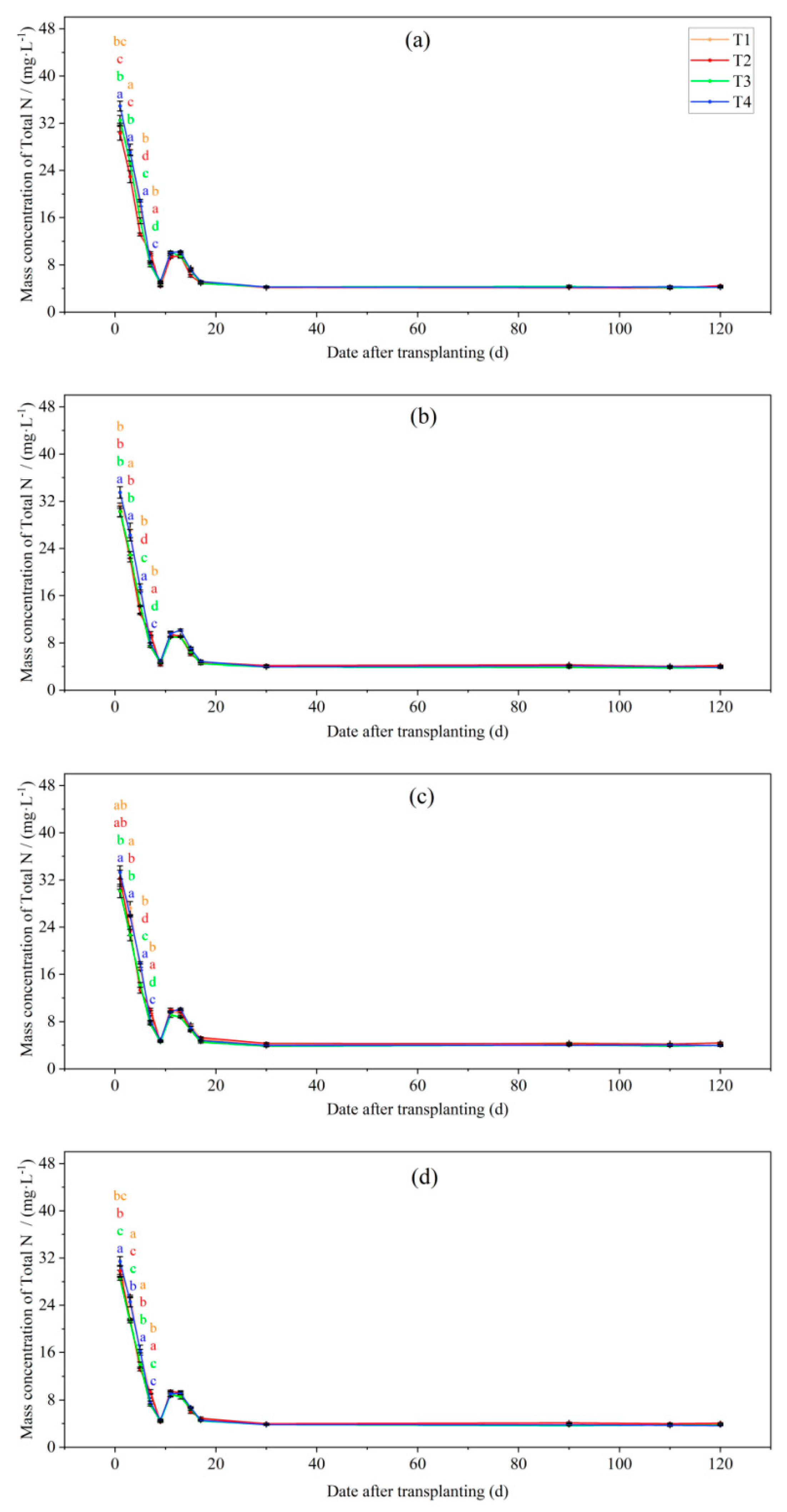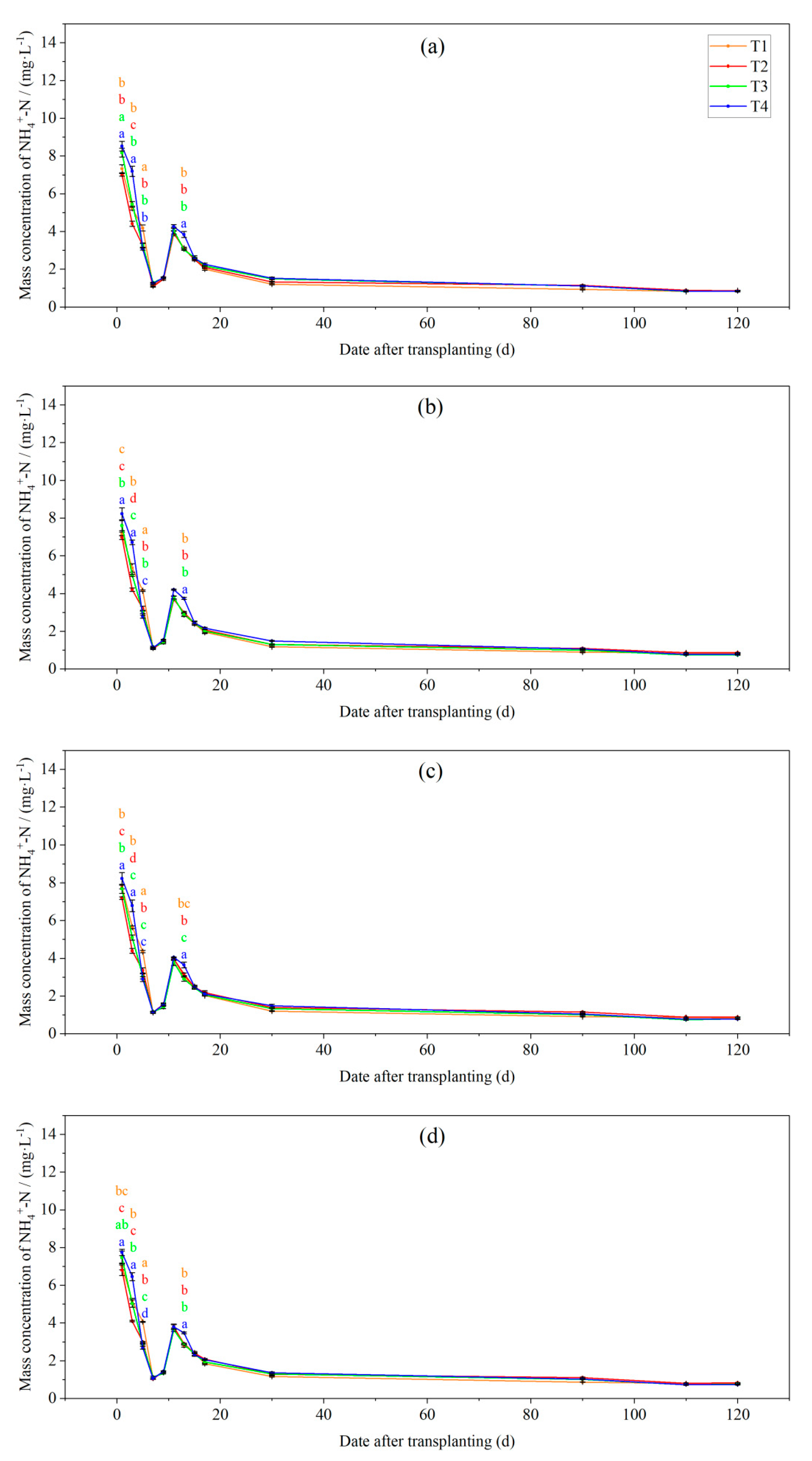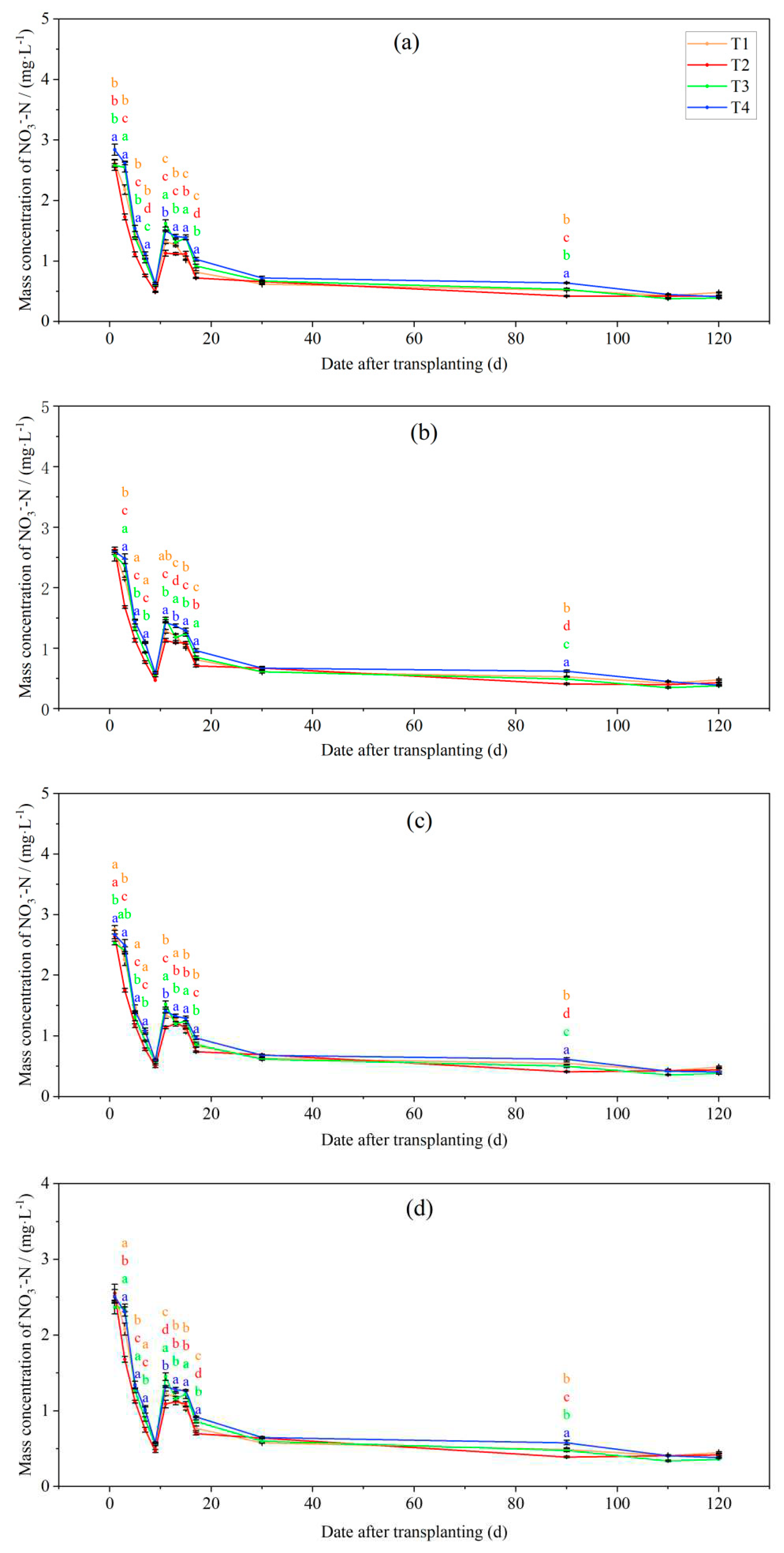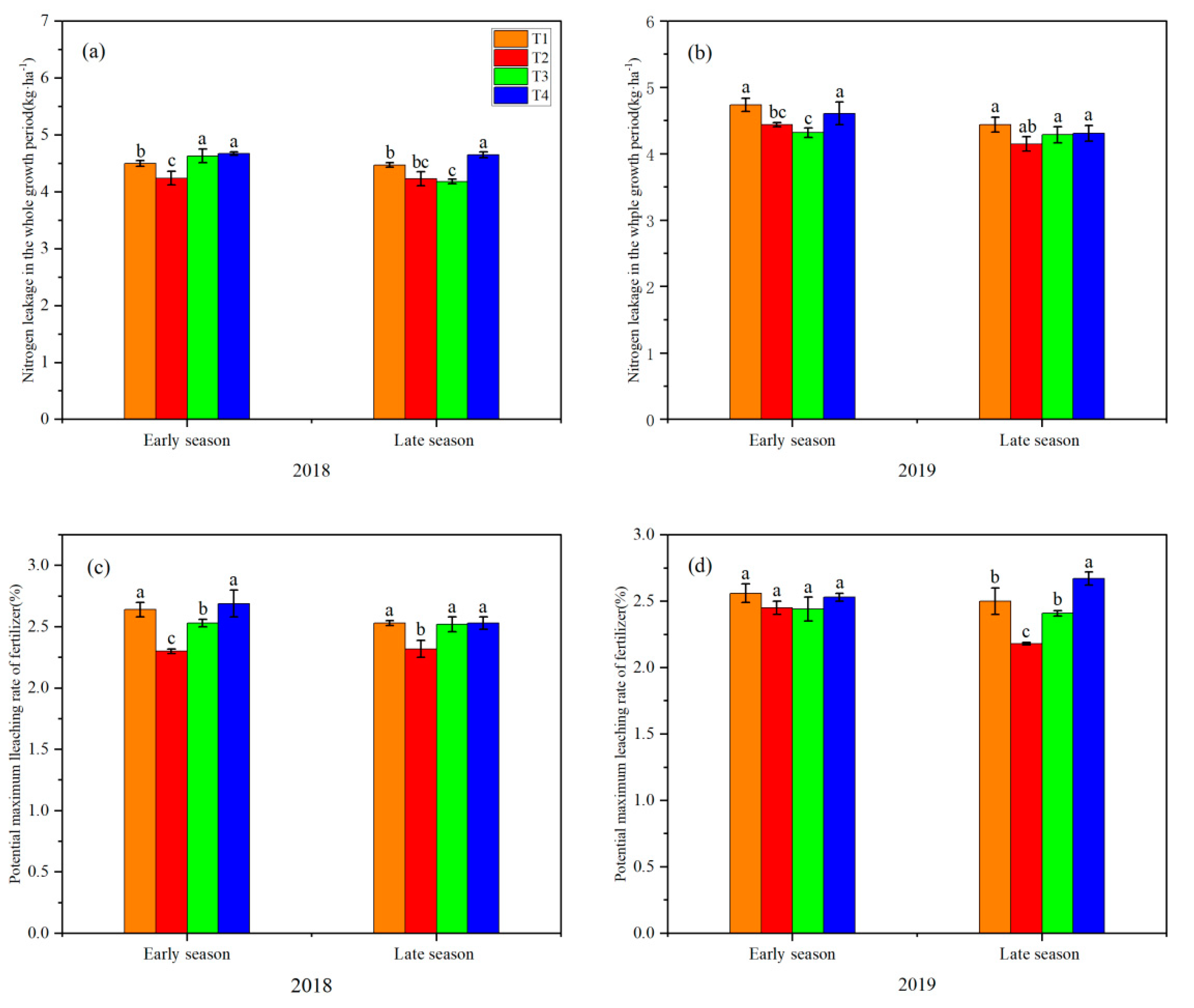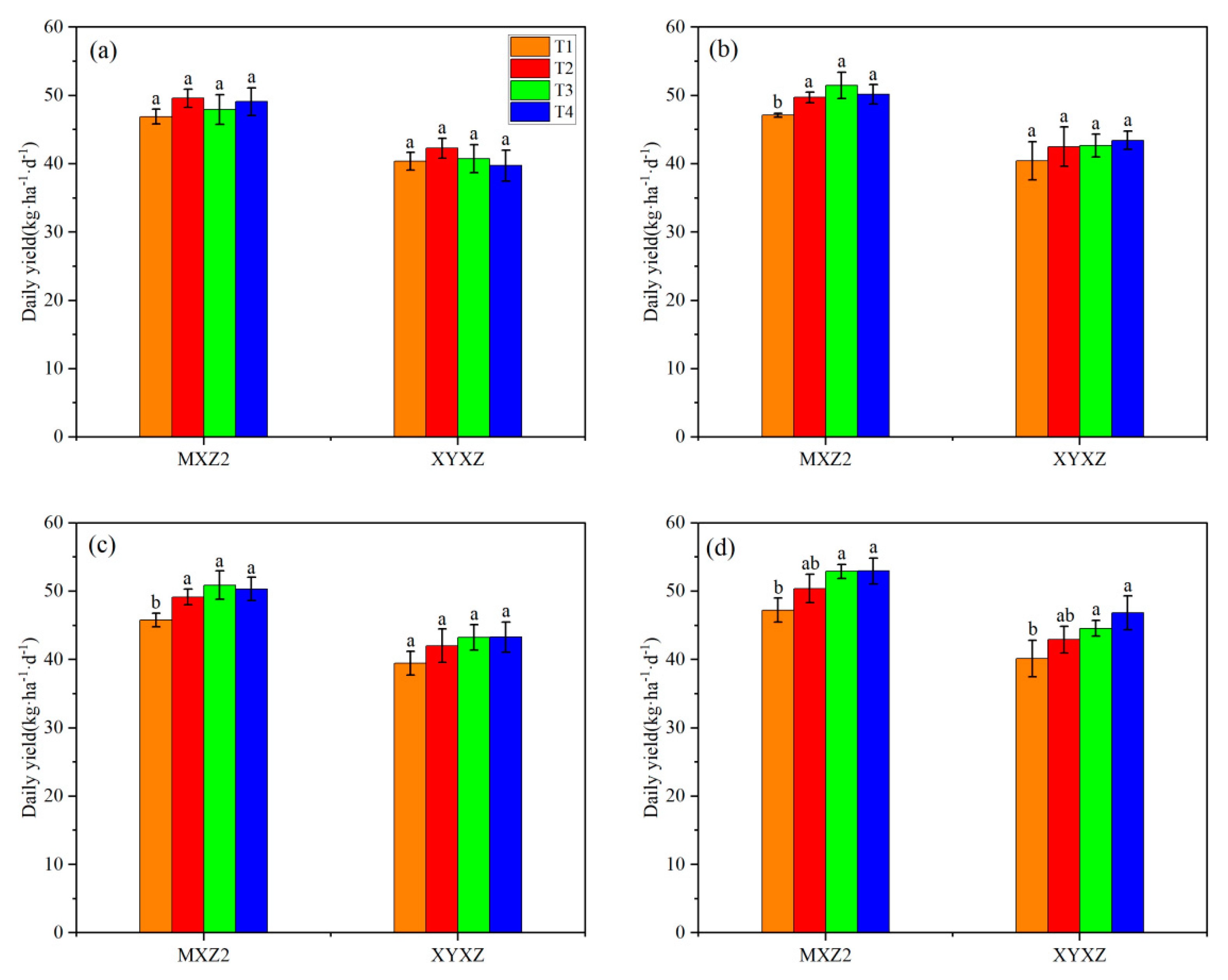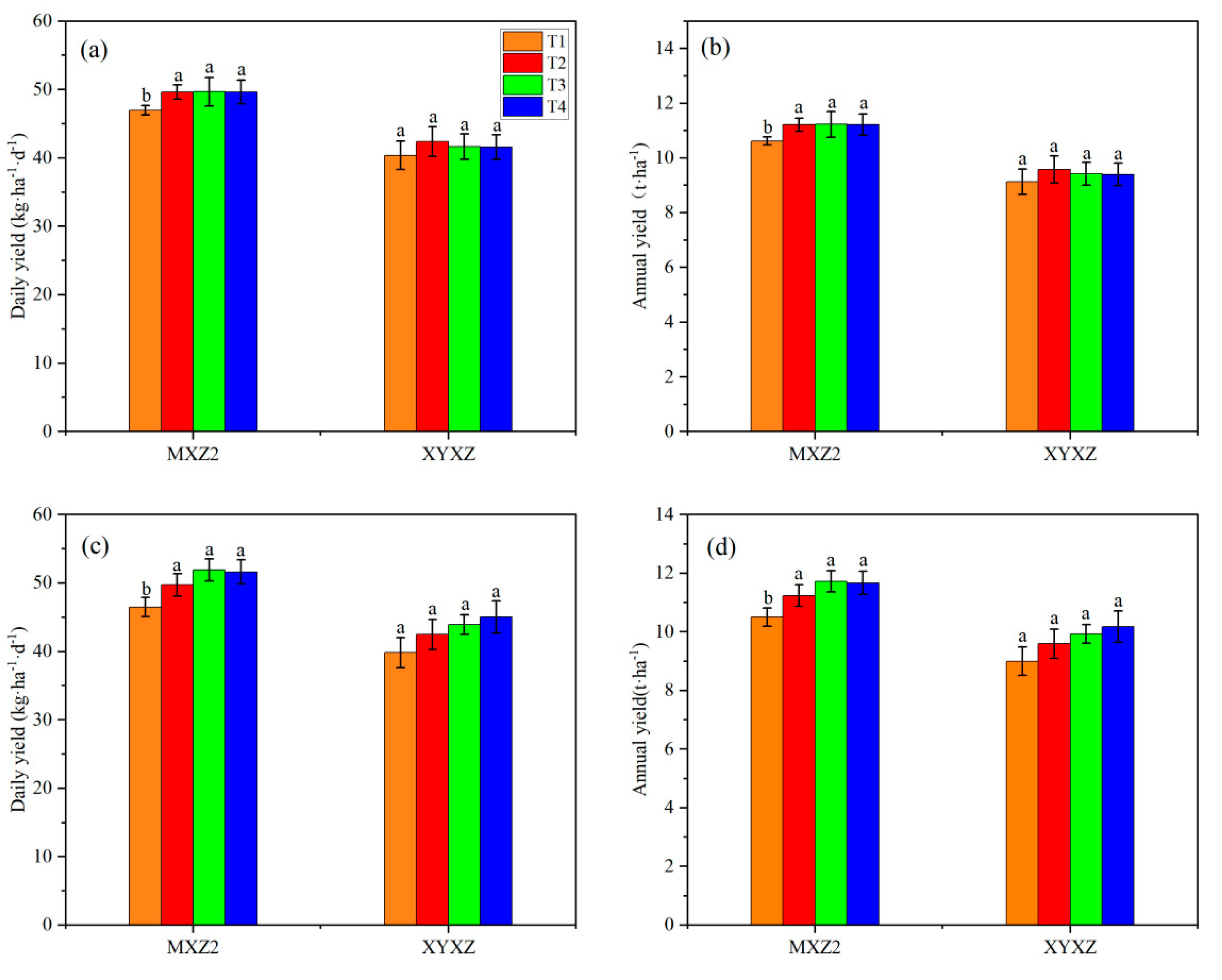1. Introduction
As the global population continues to grow, food security has become a paramount challenge on a global scale [
1]. The global population is projected to surpass 9 billion around 2037 and exceed 10 billion by approximately 2058 [
2]. This will result in a projected increase in food consumption ranging from 60% to 102%[
3], making the sustainability and efficiency of agricultural production increasingly vital.
Nitrogen is considered the primary limiting nutrient for crop yield [
4]. Nitrogen leaching is the process by which nitrogen compounds, such as nitrates (NO
3-) and ammonium (NH
4+), are washed or leached out of the soil and into groundwater or surface water bodies[
5].Annually, approximately 120 Tg of reactive nitrogen is industrially produced, with nearly 50% used for fertilizing the three major grains: maize, wheat, and rice[
6]. However, less than 40% of nitrogen fertilizer is absorbed by crops, while the remainder is lost in various forms, including nitrate (NO
3−), ammonia (NH
3), and nitrous oxide (N
2O)[
7], These losses contribute to increased agricultural production costs, water pollution, climate change, and a wide range of agricultural, environmental, and health issues [
8,
9,
10]. Proper nitrogen application and management are not only crucial for increasing crop yields but also closely related to protecting soil quality and preventing water pollution.
Precision fertilization, involving optimized timing, methods, fertilizer selection, and sound cultivation practices, significantly improves nitrogen fertilizer efficiency. Research conducted by Zewei Jiang et al. demonstrated that compared to traditional fertilizers, controlled-release urea (CRU) reduced nitrogen leaching and NH3 volatilization by 21.10% and 35.88%, respectively [
11]. The findings from Dongliang Qi et al. revealed that the use of a composite fertilizer (60% polymer-coated urea + 40% conventional urea) in conjunction with alternate wetting and drying (AWD) substantially decreased nitrogen runoff and leaching. Total nitrogen loss through runoff decreased from 35.3% to 25.0%, and total nitrogen loss through leaching decreased from 41.7% to 30.3%[
12]. Long, Guangqiang et al. found that intercropping had an impact on nitrogen in maize and potato crops, with potential reductions in NO
3−-N infiltration averaging 15.8% (ranging from 3.4% to 37.4%), and the mitigation effect on NO
3−-N infiltration increased with increasing nitrogen levels [
13].
Conservation Tillage is a sustainable agricultural technique that involves reducing soil tillage, retaining crop residues, and adopting practices like no-till farming. It serves to improve agricultural ecological environments, mitigate soil erosion risks, enhance soil quality and fertility, consequently boosting agricultural productivity[
14].Importantly, it reduces the reliance on pesticides and chemical fertilizers, thus reducing agriculture's adverse environmental impact and promoting sustainable agricultural production [
15,
16]. While the impact of conservation tillage on N leaching varies in different studies, with some reporting an increase[
17], others a decrease [
18,
19] and some finding no discernible impact[
20], its overall benefits are evident.
Deep fertilizationis a soil fertility management method aimed at incorporating fertilizers deep into the soil to better meet the nutritional needs of plants[
21]. This method typically involves applying fertilizers to deeper layers of the soil rather than just on the surface[
22]. Deep fertilization can help improve the distribution of nutrients in the soil, enhance crop nutrient uptake efficiency, and reduce the risks of nutrient wastage and environmental pollution.Furthermore, it has proven highly effective in mitigating nitrogen leaching[
23]. Deep fertilization not only reduces reliance on chemical fertilizers, decreasing the risk of agricultural environmental pollution[
24,
25],but also improves soil quality, reducing nutrient loss from soils and promoting long-term land productivity for sustainable agriculture development[
23]. Additionally, this technique reduces the risk of nitrogen leaching by ensuring that fertilizers are applied near the roots, reducing fertilizer residence time in the soil [
26].
Conservation tillage and deep fertilization both have the potential to influence nitrogen leaching, but there is limited research on the combined effects of tillage and fertilization on yield and nitrogen leaching of fragrant rice in detailed. Therefore, we conducted a two-year field experiment to investigated the concentrations of total nitrogen, ammonium nitrogen, and nitrate nitrogen, as well as grain yield and other physiological parameters, were monitored at a depth of 1 meter below the ground, to assess the impact of conservation tillage and deep fertilization on nitrogen leaching. Our results provide valuable insights into tillage and fertilization strategies for the production of fragrant rice.
2. Materials and Methods
2.1. Experimental Site Description
Field experiments were conducted in early and late seasons of 2018 and 2019, at the Experimental Research Farm, College of Agriculture, South China Agricultural University, Guangzhou City, China (23◦130 N, 113◦810 E, altitude 11 m). The region has a subtropical monsoon climate, with the majority of the rainfall occurring from May to July. The average temperature in 2018 was 23.5°C, with a rainfall of 2153.67 mm. In 2019, the average temperature was 23.98°C, and the rainfall amounted to 2549.4 mm. The soil in the experimental field was sandy loam with 1010 mg kg−1 total N, 1080 mg kg−1 total P, 20,230 mg kg−1 total K, 73 mg kg−1 available P, 104 mg kg−1 available K, and 21,560 mg kg−1 organic C.
2.2. Experimental Treatments and Design
The experiment employed a randomized complete block design with four replications and a factorial arrangement of treatments. There were primarily two groups of rice varieties. Within each group, the main factor was the tillage method with three levels: no-till, reduced tillage, and conventional tillage, while the secondary factor was deep fertilization with two levels: simultaneous deep fertilization and regular fertilization. The experimental treatments comprised conventional tillage with regular fertilization, conventional tillage with simultaneous deep fertilization, reduced tillage with simultaneous deep fertilization, and no-till with simultaneous deep fertilization. Each experimental plot had an area of 30 square meters (6 meters in length × 5 meters in width). Seeds of two rice varieties, namely conventional fragrant rice "Meixiangzhan 2" (MX) and "Xiangyaxiangzhan" (XY), were sown in rice nursery trays for seedling development. Conventional tillage was utilized as the control treatment, involving soaking the field to a depth of 4-5 cm 20 days before transplanting, tillage the soil 15 days before transplanting, tilling the soil once 10 days before transplanting, followed by machine transplanting of the seedlings on the 2nd day. Under the reduced tillage approach, after the previous crop harvest, the field was flooded to a depth of 3-4 cm and kept submerged until the rice straw became compacted. Three to five days before transplanting, a water field crop residue burial machine was used to compress the rice straw, followed by soaking the field in water at a depth of 2-3 cm. Subsequently, a rotary tiller was employed to till the soil once, maintaining a water depth of 1-2 cm until the field was leveled using a laser leveling machine. In the case of no-till farming, after the harvest and before sowing, the soil was left undisturbed, with residues from the previous crop covering the soil surface. Approximately three weeks before transplanting, when the soil surface was dry, "Roundup" 41% herbicide was sprayed at a rate of 2 bottles (200 ml/bottle) per acre to eradicate weeds. The field surface was kept dry for 5-7 days to ensure weed elimination. Then, the field was flooded to a depth of 3-4 cm and maintained submerged for 3-5 days. Afterward, the "Laser Leveling Machine" was employed to compress the rice straw. For all treatments, synchronized deep-side fertilization and transplanting were performed using a riding-type high-speed transplanting machine (PZ60ADTLF). Prior to transplanting, all treatments received a basal application of Yaran compound fertilizer (N:P:K 15:15:15) at a rate of 450 kg·hm−2. Additionally, after the initial tillering stage (5 days after transplanting) when the shallow water layer reappeared, Yaran compound fertilizer (N:P:K 15:15:15) was applied at a rate of 450 kg·hm−2. Other management practices were conducted in accordance with the "Fragrant Rice Cultivation Techniques" guidelines
Early-season rice was sown on March 12th, transplanted on April 4th, with a planting pattern of 30×14 cm, and harvested on July 8th. For all treatments, immediately after the previous crop harvest and when the field surface had dried, "Roundup" 41% herbicide was applied at a rate of 2 bottles (200 ml·bottle−1) per acre to eliminate weeds. The field surface was kept dry for 5 days to eradicate weeds. Subsequently, the field was flooded to a depth of 3-4 cm and maintained submerged for 3-5 days before being maintained at a depth of 1-2 cm on the day of transplanting.
2.3. Sampling and Measurement
A 1-meter-long percolation tube was inserted into the ground, featuring a water-permeable head at its bottom. At regular intervals thereafter, moisture samples were extracted from the percolation tube and collected. Mass concentration of NH
4+-N, mass concentration of NO
3--N, and total N mass concentration were measured by Alliance-Futura II. this equation of Total N mass concentration (P, kg ha
−1) as follows:
The values of A and H represented the nitrogen mass concentration of leaching water in the plot (mg/L), leaching loss volume (m3).
2.4. Potential Maximum Leaching Rate of Fertilizer
Select representative soil samples and place them in columns with a diameter of 10-15 centimeters and a height of 30-50 centimeters. Apply Yaran compound fertilizer (N:P:K 15:15:15) at a rate of 450 kg·hm−2 evenly on top of the columns. Provide a controlled water supply at the top of the columns using water or simulated rainfall equipment to mimic precipitation or irrigation conditions. The water supply can be adjusted according to different rainfall intensities and frequencies.
Install collection bottles at the bottom of the columns to collect leachate that flows out from the bottom of the columns. Periodically collect samples from the leachate, and analyze the nitrogen content in the collected samples. Determine the ammonium nitrogen (NH4+-N) content in the leachate using an Alliance-Futura Ⅱ continuous flow analyzer. Based on the analysis results, calculate the amount of nitrogen fertilizer leached from the bottom of the columns and compare it with the initial fertilizer application to obtain the nitrogen fertilizer leaching percentage. Repeat the experiment three times.
2.5. Grain Yield
At maturity, ten hills were sampled diagonally from a 5 m2 harvest area to determine yield components. calculated. Grain yield was determined from a 5 m2 area in each plot 100 and adjusted to 12.5–14.5% moisture content .
2.6. Statistical Analysis
Data were analyzed using three-way analysis of variance with R 4.3.1 (Analytical Software, Tallahassee, FL, USA). Microsoft Excel 2010 and Statistic 8.0 (Analytical Software, Tallahasse, Florida, USA) were used for data collation and analysis, and the least significant difference (LSD) test was used for multiple comparisons (P < 0.05). Origin 9.0 were used to draw the graphs.
3. Result
3.1. Total N Leaching
Season, year, treatment, and their interactions all exhibited highly significant effects on Total N Leaching (
Table 1), except for the Season × Treatment interaction, which did not show significance.Throughout the entire rice growing season, the total nitrogen concentration in the leachate at a depth of 1 meter in the paddy fields exhibited a certain range of variation, ranging from 3.60 mg·L
−1 to 35.76 mg·L
−1 (
Figure 1). Compared to the T4 treatment, the total nitrogen concentrations in the T1, T2, and T3 treatments decreased by 1.20%, 7.10%, and 8.68%, respectively, with the reductions in the T2 and T3 treatments being statistically significant (P < 0.05). Specifically, the average concentrations for the four treatments were T1:10.41 mg·L
−1, T2:9.79 mg·L
−1, T3:9.62 mg·L
−1, and T4:10.53 mg·L
−1.
Under different treatments, the total nitrogen mass concentration in the runoff from the rice fields exhibited a certain pattern of variation. Firstly, during the basal fertilizer application period, the total nitrogen concentration was generally higher for all treatments. Subsequently, it rapidly decreased in the following period, with a brief increase during the tillering stage on the 9th day. Additional tillering fertilizer was applied on the ninth day,additional tillering fertilizer was applied on the ninth day, reaching a second peak on the 11th day, and finally gradually decreasing to lower concentrations and stabilizing. Overall, the trend of total nitrogen leaching was as follows: T4 > T1 > T3 > T2, and these trends showed no significant differences between different seasons.
3.2. NH4+-N Leaching
Season, year, treatment, and their interactions demonstrated highly significant effects on NH
4+-N Leaching(
Table 1), with the Year×Season interaction also displaying significance.Throughout the entire rice growing season, the ammonium nitrogen concentration in the leachate at a depth of 1 meter in the paddy fields exhibited a certain range of variation, ranging from 0.69 mg·L
−1 to 8.72 mg·L
−1 (
Figure 2). Compared to the T4 treatment, the T1, T2, and T3 treatments reduced the ammonium nitrogen concentration by 6.68%, 11.63%, and 8.68%, significantly. Specifically, the average concentrations for each season under different treatments were as follows: T1:2.65 mg·L
−1、T2:2.51 mg·L
−1、T3:2.60 mg·L
−1 and T4:2.84 mg·L
−1.
The ammonium nitrogen concentration in the leachate from deep paddy fields under different fertilization treatments exhibited a similar pattern of variation as total nitrogen. During the basal fertilizer application period, ammonium nitrogen concentration was relatively high for all fertilization treatments. Subsequently, it gradually decreased in the following period. However, there was a brief increase during the tillering stage on the 9th day when additional tillering fertilizer was applied. After that, it declined again, reaching lower concentrations and stabilizing thereafter. Overall, the trend for ammonium nitrogen was as follows: T4 > T1 > T3 > T2.
3.3. NO3--N Leaching
For NO
3--N Leaching, season, year, treatment, and their interactions revealed highly significant effects(
Table 1). Notably, Season×Treatment interaction was the only interaction that did not exhibit significance. In line with NH
4+-N, the Year×Season interaction was significantly influential.Throughout the entire rice growing season, the nitrate nitrogen concentration in the leachate from deep paddy fields at a depth of 1 meter exhibited a range of variation from 0.33 to 2.90 mg·L
−1 (
Figure 3). Low nitrate leaching concentrations are of significant importance for both environmental protection and nitrogen utilization efficiency. Specifically, the average nitrate leaching concentrations for each season under different treatments were as follows:T1:1.10mg·L-1,T2:0.98 mg·L
−1,T3:1.11 mg·L
−1 and T4:1.19 mg·L
−1.By comparing the nitrate leaching concentrations under different treatments, it is evident that, relative to the T4 treatment, the T1 treatment reduced nitrate leaching concentration by 7.45%, the T2 treatment reduced it by 17.61%, and the T3 treatment reduced it by 6.02%,significantly. This indicates that the T2 treatment exhibited the best nitrogen leaching and potential loss rate throughout the entire rice growing season, with the lowest nitrate leaching concentration. Furthermore, the dynamic trend in nitrate leaching concentration is noteworthy. Under all treatments, the nitrate nitrogen concentration in the leachate from deep paddy fields exhibited a pattern of high concentration during the basal fertilizer application period, followed by a rapid decline, additional tillering fertilizer was applied on the ninth day,a brief increase after the application of tillering fertilizer on the 11th day, and then another decline to lower concentrations, stabilizing thereafter. Overall, the trend for nitrate nitrogen was as follows: T4 > T1 > T3 > T2, with no significant differences observed between seasons.
3.4. Nitrogen Leakage in the Whole Growth Period and Potential Maximum Leaching Rate of Fertilizer
Regarding Nitrogen leakage during the entire growth period, Season and Treatment independently exerted highly significant effects(
Table 1), while the Season×Treatment interaction lacked significance. Additionally, the Year×Treatment interaction, as well as interactions involving all three factors, displayed highly significant impacts.In the case of the Potential maximum leaching rate of fertilizer, all three factors independently and their interactions demonstrated highly significant effects, while pairwise interactions were not significant.
Different planting and fertilization methods significantly influenced nitrogen leaching and potential maximum leaching rates. In terms of the total amount of nitrogen leaching over the entire crop growth period, the T4 treatment was significantly higher than the other treatments, while the T2 and T3 treatments reduced it by 6.46% and 4.49%, respectively (
Figure 4). Relative to the T4 treatment, the trend for nitrogen leaching amounts under different planting and fertilization methods in both experimental years was as follows: T4 > T1 > T3 > T2. Regarding the potential maximum leaching rates of nitrogen, the trend was similar to the nitrogen leaching amounts, with the T2 treatment reducing it by 11.23% and 9.57% compared to the T4 and T1 treatments, respectively. In both experimental years, the trend for potential maximum leaching rates of nitrogen under different planting and fertilization methods was as follows: T4 > T1 > T3 > T2. This implies that the T4 treatment had the highest nitrogen leaching and potential loss rates, followed by T1, then T3, and the T2 treatment had the lowest nitrogen leaching and potential loss rates. However, it's important to note that these differences were not statistically significant between different seasons.
Further relating these results to the changes in ammonium nitrogen, nitrate nitrogen, and total nitrogen concentrations, we observed that over the entire rice growth period, the trends in total nitrogen concentration, ammonium nitrogen concentration, and nitrate nitrogen concentration were consistent with T4 > T1 > T3 > T2, aligning with the trends in nitrogen leaching and potential loss rates. Specifically, the T4 treatment exhibited higher ammonium and nitrate nitrogen concentrations throughout the entire growth period, followed by T1, then T3, and the T2 treatment had the lowest concentrations of ammonium and nitrate nitrogen.
In summary, the T4 treatment demonstrated higher nitrogen leaching and potential loss rates throughout the entire rice growth period, resulting in higher concentrations of total nitrogen, ammonium nitrogen, and nitrate nitrogen during the corresponding periods. Conversely, the T2 treatment performed optimally in reducing nitrogen leaching and potential loss rates, resulting in the lowest leaching of total nitrogen, ammonium nitrogen, and nitrate nitrogen. This suggests that, compared to conventional fertilization, synchronized deep fertilization is more effective in reducing nitrogen leaching, while conventional tillage, reduced tillage, and no-till actually lead to increased nitrogen leaching. For rice production, the best approach to reduce nitrogen leaching is conventional tillage with synchronized deep fertilization. It's important to emphasize that these differences were not statistically significant between seasons. These findings are of great significance for optimizing rice planting and fertilization management, improving nitrogen utilization efficiency, and reducing nitrogen pollution. However, further research is needed to delve into the mechanisms of nitrogen leaching under different treatments.
3.5. Daily Yield
Each factor independently had a highly significant impact on yield(
Table 1). However, after considering interactions, only the Year×Treatment interaction showed significant influence.This study also analyzed the impact of different planting and fertilization methods on daily rice yield. For the "Meixiangzhan 2" variety, in three out of four seasons except for the early season of 2018, the daily yield under the T1 treatment was significantly lower than that under the other treatments (
Figure 5). Specifically, in the late season of 2018, the yield under the T1 treatment was lower than that under the T2, T3, and T4 treatments, decreasing by 4.93%, 5.26%, and 6.93%, respectively. In the early season of 2019, the T1 treatment's yield was lower than that of the T2, T3, and T4 treatments, decreasing by 6.04%, 8.73%, and 8.79%, respectively. In the late season of 2019, the T1 treatment's yield was lower than that of the T2, T3, and T4 treatments, decreasing by 6.46%, 9.93%, and 14.29%, respectively. As for the "Xiangyaxiangzhan" variety, only in the late season of 2019, the T1 treatment's daily yield was significantly lower than the other treatments, decreasing by 6.26%, 10.71%, and 10.81%, compared to the T2, T3, and T4 treatments, respectively.
From the above results, it can be observed that for the "MX" variety, the daily yield under the T1 treatment was significantly lower than that under the other treatments in different seasons, with differences ranging from 4.93% to 14.29%. As for the "Xiangyaxiangzhan" variety, only in the late season of 2019, the T1 treatment's daily yield was significantly lower than the other treatments, with differences ranging from 6.26% to 10.81%. Combining these conclusions with the previous results on nitrogen leaching and potential loss rates, it appears that the T1 treatment exhibited lower yields and simultaneously showed higher nitrogen leaching and potential loss rates. This may imply lower nitrogen utilization efficiency in this treatment, resulting in greater nitrogen losses and subsequently affecting rice growth and yield.
In summary, different planting and fertilization methods are closely related to rice yield and nitrogen leaching. When optimizing rice planting management strategies, apart from considering yield improvement, it is essential to also take into account nitrogen utilization efficiency to reduce nitrogen losses and enhance agricultural sustainability. Future research can delve deeper into the mechanisms of nitrogen loss under different treatments to further guide practical planting operations.
3.6. Daily Yield and Annual Yield
In this study, we conducted an in-depth analysis of the impact of different planting and fertilization methods on the annual yield of different rice varieties (see
Figure 6). Specifically, for the "Meixiangzhan 2" variety, the daily yield under the T1 treatment was significantly lower than that under the other treatments. In three out of four seasons, except for the early season of 2018, the T1 treatment's yield was lower than that of the T2, T3, and T4 treatments. Specifically, in 2018, the T1 treatment's yield was lower than that of the T2, T3, and T4 treatments, decreasing by 5.35%, 5.43%, and 5.35%, respectively. In 2019, the T1 treatment's yield was lower than that of the T2, T3, and T4 treatments, decreasing by 6.49%, 10.40%, and 9.94%, respectively. However, for the "Xiangyaxiangzhan" variety, no significant differences were observed among different planting and fertilization methods, and the trend in annual yield was consistent with that of daily yield. Through comprehensive analysis, we can conclude that the T1 treatment significantly reduced daily yield, especially in different seasons of 2018 and 2019, in the "Meixiangzhan 2" variety. However, for the "Xiangyaxiangzhan" variety, no significant impact of different planting and fertilization methods on yield was observed, and the trend in annual yield was consistent with that of daily yield.
These findings suggest that planting and fertilization methods may have varying degrees of impact on the yield performance of different rice varieties. When selecting different varieties and formulating planting management strategies, it is essential to consider variety characteristics and nitrogen utilization efficiency to achieve optimal yield and nitrogen management effects. Future research can further explore the interaction mechanisms between different varieties and different planting and fertilization methods, providing more scientific basis for precision agriculture.
3.7. Correlation Analysis and Principal Component Analysis (PCA)
To delve further into the mechanisms underlying the impact of different planting and fertilization methods on rice yield, we conducted a comprehensive analysis of the relationship between yield and total nitrogen, ammonium nitrogen, nitrate nitrogen, as well as the entire nitrogen leaching amount and potential leaching rate. The results indicate that in this study, no significant correlations were observed between yield and these nitrogen-related parameters. Specifically, despite observing trends in yield variations under different treatments, the correlations between yield and total nitrogen, ammonium nitrogen, and nitrate nitrogen were not statistically significant. Although nitrogen leaching amount and potential leaching rate differed among different treatments, their relationships with yield did not reach statistical significance. This finding suggests that, under the conditions of this study, the relationship between yield and nitrogen may be influenced by multiple factors, rather than being determined solely by a single factor. There may be a complex interplay of various factors, such as other environmental factors, growth stage phases, and soil characteristics, which could collectively overshadow the direct relationship between yield and nitrogen.
In summary, we conclude that the relationship between yield and total nitrogen, ammonium nitrogen, nitrate nitrogen, nitrogen leaching amount, and potential leaching rate is relatively complex under different planting and fertilization methods. Further in-depth research is needed to uncover the underlying mechanisms. This also reminds us that in future studies, we should consider a more comprehensive range of influencing factors to accurately unravel the relationship between nitrogen and yield.
Figure 7.
The correlations between grain yield and total nitrogen (a), ammonium nitrogen (b), nitrate nitrogen (c), nitrogen leaching in the whole growth period (d), and potential leaching rate (e), as well as PCA of all investigated parameters (f).
Figure 7.
The correlations between grain yield and total nitrogen (a), ammonium nitrogen (b), nitrate nitrogen (c), nitrogen leaching in the whole growth period (d), and potential leaching rate (e), as well as PCA of all investigated parameters (f).
4. Discussion
“N leaching” refers to the leaching or loss of nitrogen in the soil, typically occurring when nitrogen in the soil is washed away into groundwater during the process of water flow[
27,
28,
29]. This leaching is often the result of factors such as rainfall, irrigation, or other water input pathways[
30,
31].Previous studies have assessed cultivation methods such as straw mulching, intercropping, irrigation practices, and fertilization management, as well as environmental factors like soil properties, and other substances like nitrification inhibitors, controlled-release coated urea, biochar, and their impacts on N leaching[
13,
32,
33,
34,
35,
36,
37,
38].These results indicate that it is possible to reduce N leaching through conservation tillage and deep fertilization. According to reports, compared with conventional tillage, no-tillage has been demonstrated to increase [
39], decrease [
18,
19] or have no significant impacts[
20] on N leaching. Deep fertilization can reduce N leaching and enhance nitrogen utilization efficiency[
25,
40,
41].In this study, we systematically investigated the impact of different planting and fertilization methods, combined with synchronized deep fertilization, on nitrogen leaching and rice yield. Although previous research has emphasized the importance of nitrogen management for agroecosystems[
42],the relationship between yield and nitrogen under different planting and fertilization methods remains uncertain. Through four rice seasons of field experiments, we have drawn valuable conclusions while also revealing complexities and challenges.
Firstly, our findings indicate that different planting and fertilization methods significantly affect nitrogen leaching. Specifically, T2 and T3 treatments exhibited lower levels of total nitrogen, ammonium nitrogen, and nitrate nitrogen concentrations, while T4 treatment was significantly higher than others. Under the same fertilization method, the extent of nitrogen leaching was found to be in the order of no-tillage > reduced-tillage > conventional tillage, consistent with the results of Zhang et al [
43].Furthermore, the treatment of conventional tillage combined with synchronized deep fertilization (T2) showed the best performance in terms of nitrogen leaching and potential leaching rate, indicating its potential advantages in nitrogen management. However, it's important to note that although some differences existed, the variations in nitrogen leaching under different treatments were not statistically significant across different seasons. This could be attributed to various factors, including meteorological conditions and soil properties[
37].According to Li et al.'s research, the response of NO
3−-N leaching is associated with soil attributes such as Soil Organic Carbon (SOC), climatic factors, specifically water input, and management practices like the duration of No-Till (NT) and nitrogen fertilizer input. SOC emerges as the most pivotal factor influencing NO
3−-N leaching risk under NT conditions [
44]. Extended periods of NT have been shown to effectively enhance SOC content [
45].This study was conducted during the second and third years of no-tillage cultivation, during which nitrogen leaching levels in no-tillage were observed to be higher compared to conventional tillage practices. These findings align with the data collected by Li and colleagues[
44].
Secondly, a clear contrast between conventional tillage (T1) and conventional tillage with synchronized deep fertilization (T2) is evident in our study. We observed that T2 treatment exhibited lower levels of total nitrogen, ammonium nitrogen, and nitrate nitrogen concentrations, which aligns with the findings of Liu et al. [
46].This suggests that, during fertilization, controlling the timing and depth of nitrogen application to match the growth requirements of rice plants can effectively reduce nitrogen loss, particularly during the early growth stage of rice when seedlings are small, root systems are underdeveloped, and nitrogen uptake and retention in the paddy water are limited. Deep fertilization can better balance the nitrogen release rate, matching the nitrogen uptake rate of rice plants, thus reducing nitrogen retention time in the soil and the likelihood of nitrogen leaching [
25].Liu et al. [
47] found that deep nitrogen fertilization significantly increased dry matter, nitrogen uptake, and yield in rice, with the 10 cm depth treatment showing the highest nitrogen use efficiency and grain yield. Additionally, Fan et al. [
48]reported that deep nitrogen fertilization mitigated environmental impacts of the nitrogenation process, such as anodic uptake, nitrogen treatment on the surface of nitridation, nitridation rinsing, and denitrification, especially in NT rice fields.
Lastly, despite observing trends in yield variations under different treatments, we did not find significant correlations between yield and nitrogen-related parameters, such as total nitrogen, ammonium nitrogen, and nitrate nitrogen. This phenomenon differs from some existing literature results[
48]and may be attributed to various factors, including soil types, rice varieties, and other ecological factors. This highlights the need to consider a comprehensive range of influencing factors when studying the relationship between nitrogen and yield.
In summary, we conclude that the relationship between yield and nitrogen leaching under different planting and fertilization methods is not straightforward and is influenced by multiple factors. Future research should further explore the relationship between different nitrogen management strategies and yield while considering a broader range of environmental factors and ecological mechanisms to gain a deeper understanding of nitrogen behavior and its impacts in agroecosystems.
Overall, this study provides new insights for nitrogen management and agroecosystem research, offering a scientific basis for future field management and environmental protection. However, further research is necessary to address the complexity and uncertainty within these findings to better guide sustainable agricultural practices.
